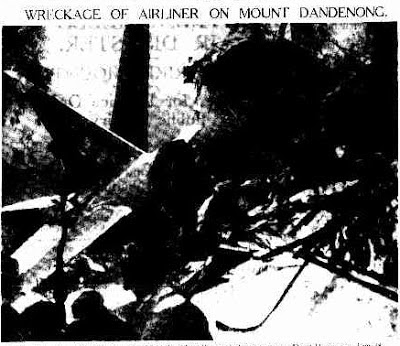October 25 1938: A twin propeller DC - 2, the Kyeema, took off from Adelaide airport bound for Melbourne. A few hours later, the plane would crash into the side of Mount Dandenong, north east of it's destination, killing all 18 people on board. At the time it was the worst aviation disaster to occur in Australia.
 |
| A DC-2 in flight. |
Taking off at 11.20am, the flight had gone smoothly until the plane began its approach to Melbourne. Encountering thick, low cloud and fog the pilots fatally miscalculated their position. Aiming for Essendon airport, when they broke through below the cloud cover they found that they had overshot the city and were on a collision course with the Dandenongs.
What happened in the final moments of the flight is uncertain, but the crash itself was vividly reported in the local press:
 |
| Headline picture from the Sydney Morning Herald, the morning after the crash. |
First on the scene after the crash were two labourers, identified in the press as R.Lowden and A.Murphy, who were clearing timber nearby. Lowden's eyewitness report:
This West Australian paper also noted that a Perth couple on their honeymoon were among the victims.
But Lowden's testimony about the plane banking into the mountainside is important. At the public enquiry established into the cause of the crash, aviation experts speculated that the pilots may have become disorientated and accidentally flown the plane into the mountain in the course of trying to avoid it. Depending on how far they were from Mount Dandenong when they left the cloud cover, the pilots may have only had a few seconds to react in any case.
The Kyeema inquiry, large enough to be held in Melbourne's Royal Exhibition Building, would eventually confirm that human error had caused the crash. Navigating largely by landmarks, as was normal at the time, the second pilot in the plane had confused the rural town of Daylesford with a town much closer to Melbourne, most likely Sunbury or Gisborne. This meant that the crew thought they were further away from the city than they were, leading to the fatal overshoot.
But while the investigation would confirm that this navigating mistake had lead to the crash, it would also make important safety recommendations that would reshape Australian aviation.
Responsibility for the oversight of civilian aviation would move from within the Department of Defence, where it was not given a high priority, to a standalone body, the Civil Aviation Authority. The new body would be given increased resources and policing powers.
The revised CAA would instigate a reform of Australia's Air Traffic Control system, moving towards instrument based navigation in an attempt to reduce human error based accidents. The Kyeema investigation had discovered that Essendon airport already had a powerful radio beacon, installed some eighteen months before the crash, that was not in regular use.
After the crash, a network of similar transmitters would be deployed across Australia, one of the first countries to do so, as one step in an overall improvement of air traffic management.
This sad, but important, moment in local history is commemorated by a small memorial near the summit of Mount Dandenong.






No comments:
Post a Comment